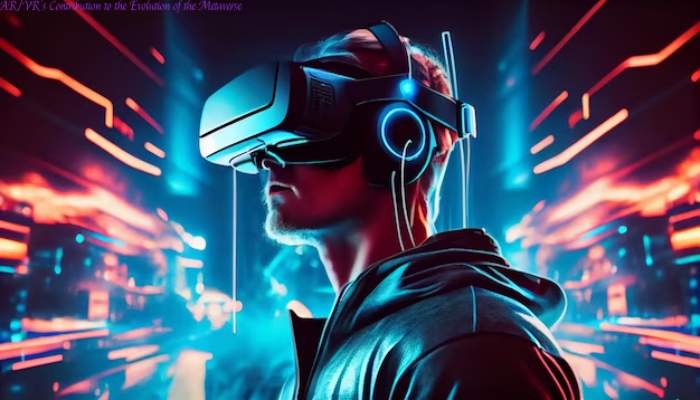AR/VR’s Contribution to the Evolution of the Metaverse

AR/VR's Contribution to the Evolution of the Metaverse
The Metaverse tops the list of audacious new technological ideas from the previous year. The idea soon attracted supporters and detractors since it raised more concerns than resolved. It’s time to discover more about the Metaverse if you haven’t already. Is it an advanced form of virtual reality or something different? Is it imaginable without AR/VR technology?
With the developments that are now gaining pace, AR and VR app development has the potential to fundamentally alter how customers interact with businesses and their goods and services.
Table of Contents
The Metaverse’s Definition
People can communicate with one another using a variety of technologies in the Metaverse, a virtual environment. Hardware and software are used in tandem to accomplish this. The concept’s vision varies from business to business, but they all have a network of real-time produced 3D environments that many individuals can enter at once.
The Metaverse is envisioned as a virtual setting where you can work, study, communicate, unwind, and participate in virtual performances, among other activities.
Since users may buy and sell items in the Metaverse much like they can in the real world, this drives brand interest. The Metaverse is heavily reliant on the digital economy. Because modern people spend so much time online, marketing products on virtual platforms like the Metaverse may be a fantastic way for firms to increase revenue.
What Role Does AR/VR Play in the Metaverse?
The ideas of the Metaverse (VR), augmented reality (AR), and virtual reality (VR) are all closely related to one another. Augmented reality technology allows for the integration of virtual items into the real world. Using 3D computer modeling, one of the most exciting types of graphic design, VR involves submerging the user in a 3D virtual environment.
For instance, it is anticipated that the Facebook metaverse, which will bridge the gap between the virtual and real worlds, will be accessible through augmented reality glasses, headsets, and limited desktop and mobile applications.
According to Statista and Morgan Stanley, the combined AR/VR market could be worth up to $300 billion by 2024 and $100 billion by 2030.
AR and VR Use Cases in the Metaverse
The Metaverse is most often associated with gaming, although its creators’ main goal is to change how people interact with the Internet. Thus, there may be many more applications. The gaming industry has been the first to benefit from the advent of virtual environments.
The Metaverse will be helpful for enterprises in advertising, tourism, education, entertainment, retail, design, engineering, and many other fields. Any physical world activity can affect the Metaverse.
As the Metaverse develops, we’ve previously suggested virtual office space, which might look different. This technology, as opposed to the more well-known Zoom and Skype, strengthens the impression that the entire team is in the same place.
While the sites mentioned above offer features like picture masking, which lets you change a meeting’s background, the Metaverse goes even further. It offers 3D-generated avatars based solely on your movements and facial expressions to represent you in virtual meetings.
There are currently comparable use cases for sale. Virtuworx offers specialized virtual reality and mixed reality solutions for businesses, virtual meetings, and other events.
The Metaverse’s future with AR/VR technology
Although it seems like a lot of fun, predicting what the Metaverse will look like is difficult. Creating something like this would probably benefit from the development of 5G and the rising interest in VR/AR technologies. The creators of the Metavers will face several challenges, though.
One is the interoperability of digital objects, which is essential for building the Metaverse. You must be sure you have the right to utilize a digital thing in the Metaverse across the entire virtual ecosystem before purchasing it, not just in one game or on one platform.
Real-time data synchronization is necessary for the Metaverse but can be challenging and costly at scale. For businesses that offer data synchronization services, the Metaverse will have to manage heavy traffic and transfer high-quality data while meeting the unique security requirements of each user.
The Metaverse relies heavily on virtual and augmented reality. Therefore, the future of AR/VR businesses seems promising. Companies who intend to create AR applications or incorporate virtual reality components stand a high chance of satisfying consumer demand. Mordor Intelligence predicts that the global VR market will grow to $184.66 billion by 2026.
Conclusion
Computer enthusiasts expect the Metavere to usher in a new stage in developing the Internet, erasing boundaries and enabling total immersion in the virtual world. The business is anticipated to grow quickly in the following years because virtual and augmented reality is crucial to developing metaverses.
Virtual reality is a way to enter the Metaverse if it is a virtual environment. You need to contact a mobile app development business to use AR/VR technology.
On the other hand, present technology, which is both pricey and uncomfortable for prolonged usage, frequently limits the capabilities of VR. Contrarily, AR has emerged as a go-to technology for the massive expansion of the Metaverse because of modern smartphones, which have made it accessible to billions of individuals.
Also read:-Internet Resources that Can Save You Money




